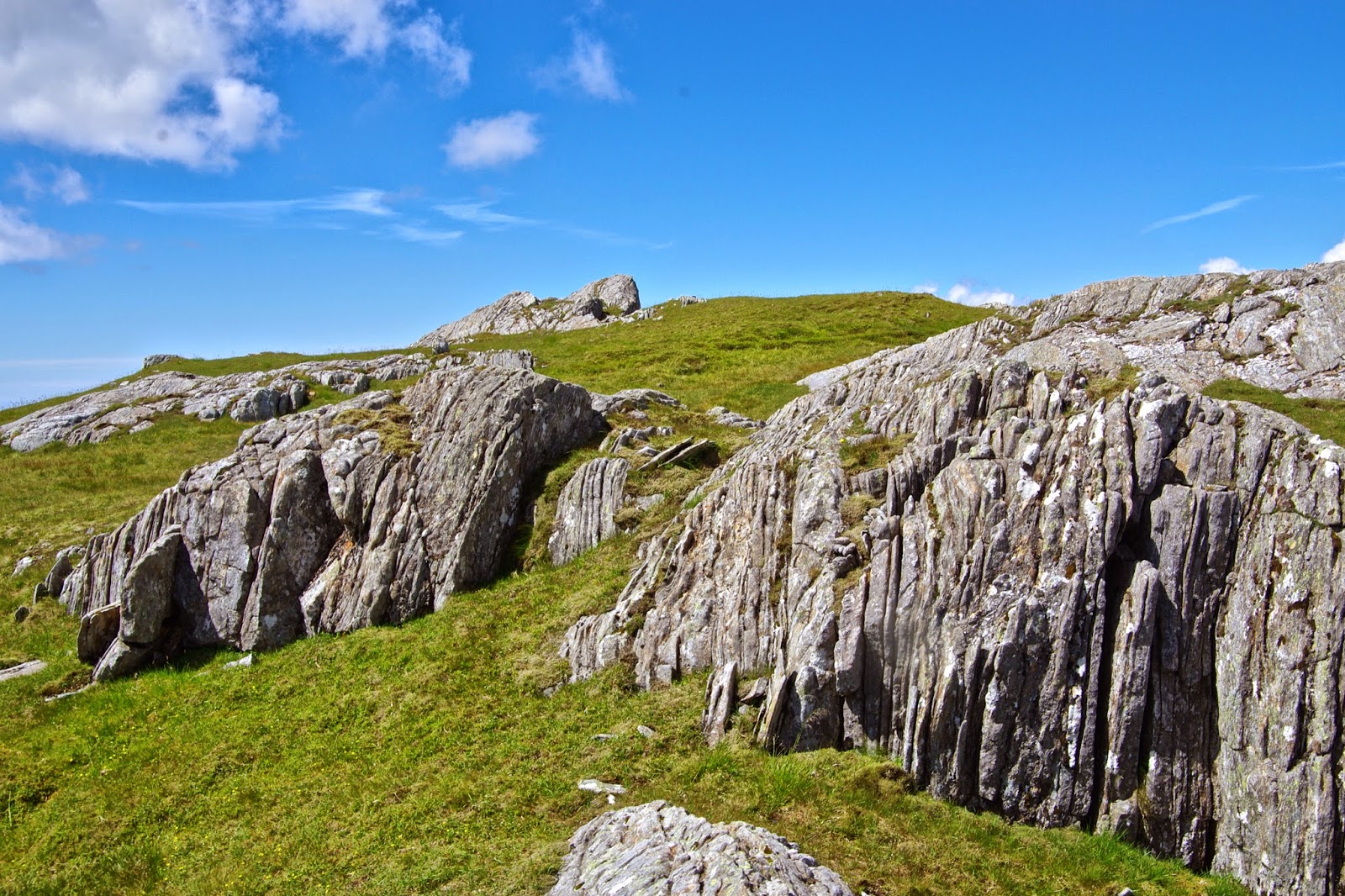 |
| Cul Beag and Stac Polly from Knockan Fault |
 |
| Inchnadamph Lodge |
I had never climbed Cul Mor or Cul Beag and, on the hottest day of the year, we set out to tackle them both from Inchnadamph Lodge. Unfortunately, John and I had underestimated the time to traverse between the two hills, because the timings in the SMC guide to the Corbetts were, unusually, too optimistic and we hadn't checked the drop in altitude to the low point between them. As a result, our planned afternoon excursion to the Summer Isles after we had been picked up by Aileen had to be cancelled as it would have prevented Aileen and Bridget from catching the ferry. We were rewarded by landscapes and waterscapes that will linger forever, they captured the essence of the thrusting primaeval geology of Inverpolly. The Summer Isles also proved a magical trip for Aileen and Bridget.
 |
| John topping out on Cul Mor |
 |
| Suilven from Cul Mor |
 |
| Cul Beag from Cul Mor |
 |
| Loch Voyatie below Suilven |
 |
| Stac Polly from Lochan Dearg a' Chuil Mhoir |
 |
| Stac Polly from Lochan Dearg, the low point between Cul Mor and Cul Beag |
 |
| Stac Polly and Loch Lugainn from Cul Beag |
 |
| Stac Polly |
Ascent: 1445 metres
Distance: 19 kilometres
Time: 7 hours 28 minutes
Cul Mor 849m 1hr 46mins
Cul Beag 769m 5hrs 22mins
We managed to get breakfast at 7:45am at Inchnadamph Lodge and set off for the 11-mile drive to the start of the path to Cul Mor adjacent to the Knockan Crag Geopark by 8:30am. It was another day of perfect sunshine and, as we discovered later, the hottest day of the year although the two previous days had been similarly blessed. The sun was even too much for the Assynt midges that had made unloading the car the evening before an act of extreme masochism. John and I had calculated that the round should take us 6 hours assuming that we finished by dropping down to Linneraineach on the Achiltibuie Road to be picked up and taken to Achiltibue for a boat trip to the Summer Isles.
The excellent stalkers' path up Cul Mor enabled us to stand on the summit well under the two hours we had scheduled. We responded by relaxing and taking in the breathtaking scenery, particularly towards the northwest where Suilven presented its awesome south face. The old red sandstone provided some finely fluted tors as we descended towards the col beneath Craig nan Calman. We headed eastwards at first and then curved to the right to cut under the layers of sandstone cliffs. This was a wild country with just the occasional deer track to aid progress as we dropped down the boulder-strewn heather slopes. We envied how painted lady butterflies and wheatears flitted across the impenetrable ground cover in contrast to our journeyman efforts. Wilderness like this is difficult to find but it nurtures the human spirit just as certainly as so-called civilisation discharges it.
This was slow walking even with the sparkling waters of Lochan Dearg a' Chuil Mhoir spurring us on. The ground was mainly dry until the edge of the Lochan and then it was a case of battering along heather-clad rocks with the occasional section of bog. At the outflow of the Lochan, we headed south, climbing slightly over a ridge and then making a long descent to the next Lochan Dearg with its red sand beach beckoning. It was after noon when we arrived and had to acknowledge that there was insufficient time to climb Cul Beag and descend to pick up a lift at 2:30pm. We decided to have lunch and enjoy the sunshine in this remote and wild place. We had dropped to 100 metres, much lower than our starting point at Knockan so that the next ascent would be bigger than climbing Cul Mor.
The climb involved a sharp scramble up the boulders and heather to reach a broken rock ledge that led upwards to the start of a steep ramp to the col between Cul Beag and its northern top. The final 180 metres was a steep but easy path through the rock bands and the summit a fine perch overlooking the impossible-to-miss Stac Polly. We sat in the heat of the afternoon for a good half hour just absorbing the atmosphere of this podium.
We decided to head back to the car as we had forsaken our lift and headed eastwards down to a col and then over the top of Meall Dearg before tumbling down the heather to the long flat broad ridge of Creag Dubh. It was pathless and energy-sapping until we reached the stalker's path for the last couple of kilometres back to the road and then to Knockan. We were back at Inchnadamph shortly after 6pm and never have a few pints been so welcome. It had been another day to celebrate the best of corbetts in this geological wonderland.
We revisited the Knockan Crag Geopark interpretation centre the following morning where I listened to Horne and Peach, the Victorian geologists who had first explained how the Moine Thrust fault had inverted the rock strata.
 |
| Bronzed Geologist with Horne and Peach |
















































